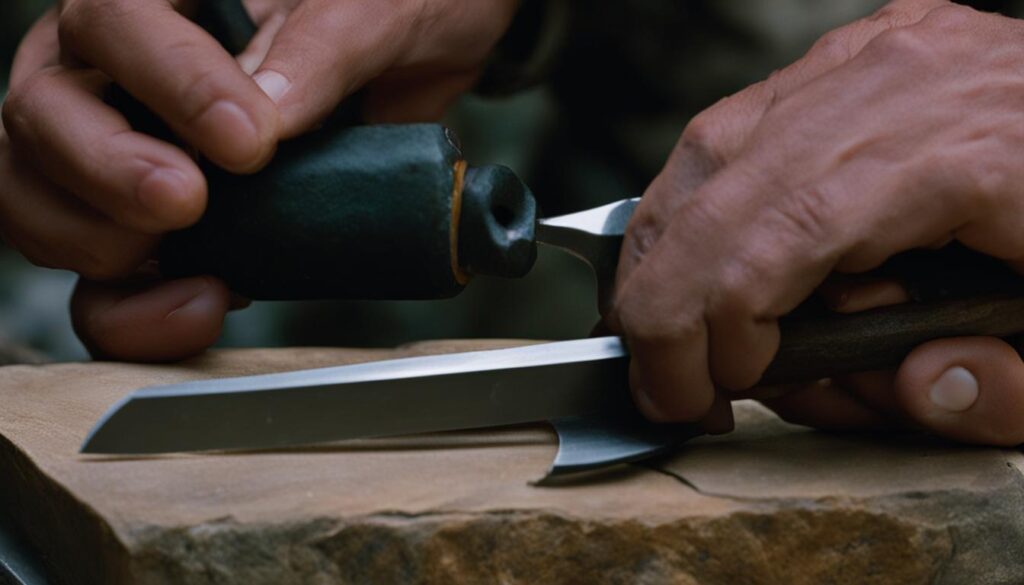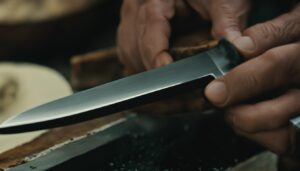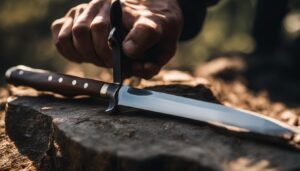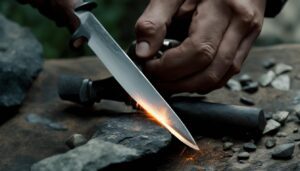Sharpening hunting knives is a crucial skill for any outdoor enthusiast. In this comprehensive guide, I will explore the world of hunting knife sharpening jigs, which are specifically designed to help you achieve a razor-sharp edge with ease and precision. We will discuss the different types of sharpening jigs available, their advantages, and how to use them effectively. Whether you are a seasoned hunter or just starting out, this guide will equip you with the knowledge and tools necessary to keep your hunting knives in optimal condition.
Key Takeaways:
- Hunting knife sharpening jigs are essential for maintaining a razor-sharp edge.
- Using a jig provides consistent angles and precise sharpening results.
- There are different types of hunting knife sharpening jigs available to suit individual needs.
- Proper usage and regular maintenance are key to achieving optimal sharpening results.
- Sharpening your hunting knife with a jig ensures clean, accurate cuts in the field.
Why Use Hunting Knife Sharpening Jigs?
When it comes to sharpening hunting knives, using a hunting knife sharpening jig can offer several advantages over traditional sharpening methods. These specialized tools provide a consistent angle for sharpening, ensuring that you achieve a precise and uniform edge every time. This is particularly important for hunting knives, as a sharp blade is essential for clean, accurate cuts in the field. With a hunting knife sharpening jig, even beginners can sharpen their knives with confidence and achieve professional results.
One of the main benefits of using a jig is that it eliminates the guesswork and uncertainty commonly associated with freehand sharpening. The jig holds the blade at a precise angle, allowing you to focus on the sharpening technique rather than worrying about maintaining the correct angle. This makes the sharpening process easier and more efficient, saving you time and effort.
Using a hunting knife sharpening jig also helps prolong the lifespan of your blades. By consistently sharpening your knives with a jig, you can maintain their optimal cutting performance throughout hunting trips. This not only enhances your overall hunting experience but also saves you money by reducing the frequency of blade replacements.
In conclusion, hunting knife sharpening jigs are a valuable tool for any outdoor enthusiast. They provide a consistent angle for sharpening, eliminate guesswork, and help prolong the lifespan of your hunting knives. With the use of a hunting knife sharpening jig, you can achieve a razor-sharp edge with ease and confidence. So, whether you are a seasoned hunter or a beginner, investing in a hunting knife sharpening jig is a wise choice to keep your blades in optimal condition.
Types of Hunting Knife Sharpening Jigs
When it comes to hunting knife sharpening, using the right jig can make all the difference. There are several types of sharpening jigs available on the market, each offering its own unique features and benefits. Let’s explore some of the most popular options:
The Veritas MKII Honing Guide
The Veritas MKII Honing Guide is a versatile jig designed to hold the blade at a precise angle during sharpening. It is known for its exceptional build quality and ease of use. The Veritas MKII can accommodate a variety of blade shapes and sizes, making it a great option for hunters with a diverse knife collection.
The Simple Honing Guide
For those on a budget, the Simple Honing Guide is a reliable and affordable choice. This jig is straightforward and easy to use, making it ideal for beginners. While it may lack some of the advanced features of more expensive models, the Simple Honing Guide still allows for accurate and consistent sharpening results.
Water Stones and Shapton Stones
In addition to jigs, water stones and Shapton Stones are popular options for achieving a polished, razor-sharp edge. These stones can be used in conjunction with sharpening jigs to further enhance the sharpening process. Water stones are known for their versatility and ability to remove material quickly, while Shapton Stones offer long-lasting durability and excellent performance.
| Jig | Features | Price |
|---|---|---|
| Veritas MKII Honing Guide | Precise angle holding, versatility | $75 |
| Simple Honing Guide | Affordable, easy to use | $20 |
| Water Stones | Versatile, quick material removal | $30 |
| Shapton Stones | Durable, excellent performance | $40 |
Choosing the right sharpening jig depends on your specific needs and preferences. Consider factors such as budget, ease of use, and the types of knives you plan to sharpen. Whether you opt for a high-end honing guide or a basic jig, using a sharpening jig in combination with quality stones will ensure your hunting knives maintain a razor-sharp edge for years to come.
How to Sharpen Hunting Knives with Jigs
Sharpening your hunting knife with a jig is a simple and effective way to achieve a razor-sharp edge. By following these step-by-step instructions, you’ll be able to sharpen your knives with precision and confidence.
The Sharpening Process
- Secure the Blade: Begin by securing the blade in the sharpening jig according to the manufacturer’s instructions. This will ensure stability and consistency throughout the sharpening process.
- Select the Grit: Choose the appropriate grit of water stone or Shapton Stone based on the level of sharpness you desire. Starting with a coarser grit and gradually progressing to finer grits will yield the best results.
- Sharpening Motion: Slide the blade across the stone in a smooth, controlled motion, maintaining the angle set by the jig. This motion helps to remove any imperfections and create a sharp cutting edge.
- Flip and Repeat: Once you’ve sharpened one side of the blade, flip it over and repeat the sharpening process on the other side. Remember to maintain the same angle and motion to ensure a uniform edge.
- Refine the Edge: Use a leather strop or honing steel to refine the edge and remove any burrs that may have formed during sharpening. This step will give your knife a polished finish and enhance its cutting performance.
With practice, you’ll develop a technique that works best for you. Remember to take your time, follow the manufacturer’s instructions, and prioritize safety throughout the sharpening process.
Benefits of Using Sharpening Jigs
Sharpening jigs offer several advantages over traditional freehand sharpening methods. One of the key benefits is the consistent angle they provide. By holding the blade at a predetermined angle, jigs ensure that you achieve a uniform edge every time. This level of precision is particularly important for hunting knives, as it directly impacts their cutting performance in the field.
Using a sharpening jig also eliminates the guesswork and uncertainty often associated with freehand sharpening. Even beginners can achieve professional-quality results with a jig, making it an ideal tool for anyone looking to sharpen their hunting knives efficiently and effectively.

By following the sharpening process and utilizing a sharpening jig, you can maintain the sharpness and performance of your hunting knives for years to come. Remember to regularly inspect and maintain your jig to ensure it is in good working condition and providing accurate sharpening angles. With dedication and practice, you’ll be able to keep your hunting knives in optimal condition, ready for your next outdoor adventure.
Tips for Using Hunting Knife Sharpening Jigs
When it comes to using hunting knife sharpening jigs, there are a few tips and tricks that can help you achieve the best results. Whether you’re a beginner or an experienced sharpener, these tips will ensure that you get a razor-sharp edge every time.
Choose the Right Jig for Your Needs
Before you start sharpening your hunting knife, it’s important to choose the right jig for your specific needs. Consider the type of blade you have, the level of sharpening you desire, and your own level of experience. Different jigs offer different angles and features, so take the time to research and select the one that will work best for you.
Follow Proper Sharpening Techniques
Once you have your jig, it’s essential to follow the manufacturer’s instructions and utilize the correct sharpening techniques. Start with a coarser grit stone and gradually move to finer grits to achieve a polished edge. Maintain a steady hand and consistent motion as you slide the blade across the stone, ensuring that both sides are sharpened evenly.
Remember, practice makes perfect. Don’t be discouraged if you’re not getting the desired results right away. With time and patience, you’ll become more proficient in using your hunting knife sharpening jig.
Maintain and Inspect Your Jig
To ensure the longevity and accuracy of your jig, it’s important to regularly maintain and inspect it. Keep the jig clean and free from any debris that may interfere with the sharpening process. Check for any signs of wear or damage, and make any necessary adjustments or repairs. By taking care of your jig, you can guarantee that it will continue to provide accurate sharpening angles for years to come.
By following these tips for using hunting knife sharpening jigs, you’ll be well on your way to achieving a razor-sharp edge on your blades. Remember to choose the right jig, sharpen with precision, and maintain your equipment properly. With practice and dedication, you’ll be able to keep your hunting knives in optimal condition and ready for any adventure in the great outdoors.
Conclusion
In conclusion, hunting knife sharpening jigs are invaluable tools for maintaining the sharpness and performance of your hunting knives. With these jigs, you can achieve a razor-sharp edge with precision and consistency, ensuring optimal cutting efficiency in the field. Regularly sharpening your knives using a jig will not only prolong their lifespan but also enhance their overall performance.
Knife maintenance is essential for preserving the quality of your blades. By choosing the right jig for your needs and following proper sharpening techniques, you can keep your hunting knives in optimal condition. Remember to prioritize safety throughout the sharpening process to prevent accidents and injuries.
Investing in a hunting knife sharpening jig is a wise decision for any outdoor enthusiast. With practice and patience, you can master the art of using these jigs and maintain a razor-sharp edge on your hunting knives. So, stay sharp and happy hunting!
FAQ
Are hunting knife sharpening jigs necessary?
Yes, hunting knife sharpening jigs offer numerous benefits over traditional sharpening methods. They provide a consistent angle for sharpening, ensuring a precise and uniform edge every time.
What are the different types of hunting knife sharpening jigs?
There are several types of hunting knife sharpening jigs available, including the Veritas MKII Honing Guide and the Simple Honing Guide. Each type has its own advantages, so it’s important to consider your specific needs and preferences.
How do I sharpen my hunting knife with a jig?
To sharpen your hunting knife with a jig, you need to secure the blade in the jig according to the manufacturer’s instructions. Then, choose the appropriate grit of water stone or Shapton Stone and slide the blade across the stone using a smooth, controlled motion.
What are some tips for using hunting knife sharpening jigs?
Some tips for using hunting knife sharpening jigs include cleaning and drying your knives before sharpening, starting with a coarser grit stone and gradually working your way up, and regularly maintaining and inspecting your jig for proper usage.
How do hunting knife sharpening jigs enhance knife performance?
Hunting knife sharpening jigs help maintain the sharpness and performance of the knives by ensuring a razor-sharp edge with precision and consistency.





